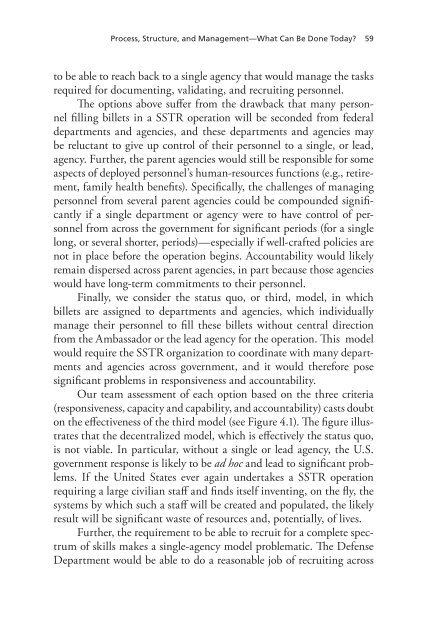Stabilization and Reconstruction Staffing - RAND Corporation
Stabilization and Reconstruction Staffing - RAND Corporation
Stabilization and Reconstruction Staffing - RAND Corporation
Create successful ePaper yourself
Turn your PDF publications into a flip-book with our unique Google optimized e-Paper software.
Process, Structure, <strong>and</strong> Management—What Can Be Done Today? 59to be able to reach back to a single agency that would manage the tasksrequired for documenting, validating, <strong>and</strong> recruiting personnel.The options above suffer from the drawback that many personnelfilling billets in a SSTR operation will be seconded from federaldepartments <strong>and</strong> agencies, <strong>and</strong> these departments <strong>and</strong> agencies maybe reluctant to give up control of their personnel to a single, or lead,agency. Further, the parent agencies would still be responsible for someaspects of deployed personnel’s human-resources functions (e.g., retirement,family health benefits). Specifically, the challenges of managingpersonnel from several parent agencies could be compounded significantlyif a single department or agency were to have control of personnelfrom across the government for significant periods (for a singlelong, or several shorter, periods)—especially if well-crafted policies arenot in place before the operation begins. Accountability would likelyremain dispersed across parent agencies, in part because those agencieswould have long-term commitments to their personnel.Finally, we consider the status quo, or third, model, in whichbillets are assigned to departments <strong>and</strong> agencies, which individuallymanage their personnel to fill these billets without central directionfrom the Ambassador or the lead agency for the operation. This modelwould require the SSTR organization to coordinate with many departments<strong>and</strong> agencies across government, <strong>and</strong> it would therefore posesignificant problems in responsiveness <strong>and</strong> accountability.Our team assessment of each option based on the three criteria(responsiveness, capacity <strong>and</strong> capability, <strong>and</strong> accountability) casts doubton the effectiveness of the third model (see Figure 4.1). The figure illustratesthat the decentralized model, which is effectively the status quo,is not viable. In particular, without a single or lead agency, the U.S.government response is likely to be ad hoc <strong>and</strong> lead to significant problems.If the United States ever again undertakes a SSTR operationrequiring a large civilian staff <strong>and</strong> finds itself inventing, on the fly, thesystems by which such a staff will be created <strong>and</strong> populated, the likelyresult will be significant waste of resources <strong>and</strong>, potentially, of lives.Further, the requirement to be able to recruit for a complete spectrumof skills makes a single-agency model problematic. The DefenseDepartment would be able to do a reasonable job of recruiting across
















